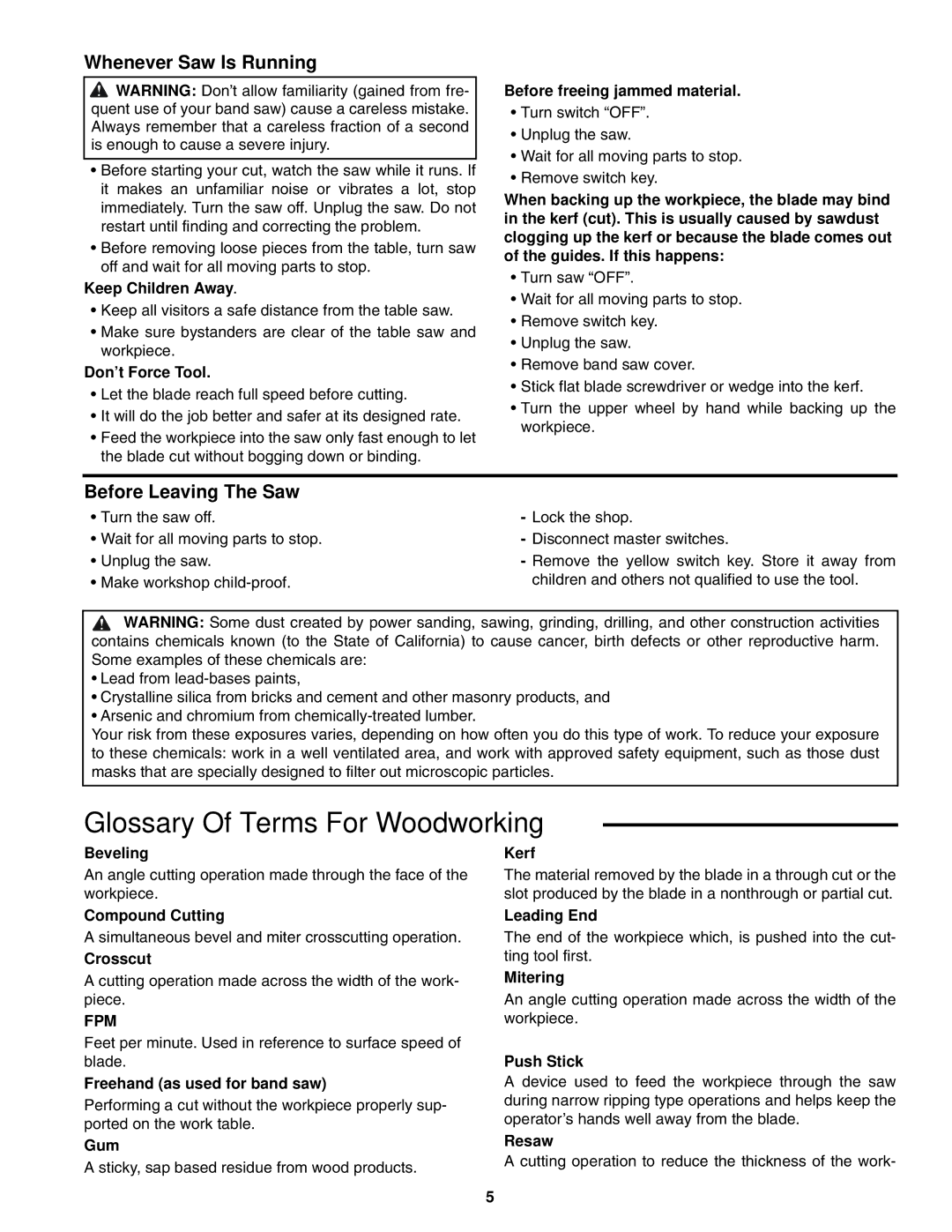
Whenever Saw Is Running
![]() WARNING: Don’t allow familiarity (gained from fre- quent use of your band saw) cause a careless mistake. Always remember that a careless fraction of a second is enough to cause a severe injury.
WARNING: Don’t allow familiarity (gained from fre- quent use of your band saw) cause a careless mistake. Always remember that a careless fraction of a second is enough to cause a severe injury.
•Before starting your cut, watch the saw while it runs. If it makes an unfamiliar noise or vibrates a lot, stop immediately. Turn the saw off. Unplug the saw. Do not restart until finding and correcting the problem.
•Before removing loose pieces from the table, turn saw off and wait for all moving parts to stop.
Keep Children Away.
•Keep all visitors a safe distance from the table saw.
•Make sure bystanders are clear of the table saw and workpiece.
Don’t Force Tool.
•Let the blade reach full speed before cutting.
•It will do the job better and safer at its designed rate.
•Feed the workpiece into the saw only fast enough to let the blade cut without bogging down or binding.
Before freeing jammed material.
•Turn switch “OFF”.
•Unplug the saw.
•Wait for all moving parts to stop.
•Remove switch key.
When backing up the workpiece, the blade may bind in the kerf (cut). This is usually caused by sawdust clogging up the kerf or because the blade comes out of the guides. If this happens:
•Turn saw “OFF”.
•Wait for all moving parts to stop.
•Remove switch key.
•Unplug the saw.
•Remove band saw cover.
•Stick flat blade screwdriver or wedge into the kerf.
•Turn the upper wheel by hand while backing up the workpiece.
Before Leaving The Saw
• Turn the saw off. | - Lock the shop. |
• Wait for all moving parts to stop. | - Disconnect master switches. |
• Unplug the saw. | - Remove the yellow switch key. Store it away from |
• Make workshop | children and others not qualified to use the tool. |
![]() WARNING: Some dust created by power sanding, sawing, grinding, drilling, and other construction activities contains chemicals known (to the State of California) to cause cancer, birth defects or other reproductive harm. Some examples of these chemicals are:
WARNING: Some dust created by power sanding, sawing, grinding, drilling, and other construction activities contains chemicals known (to the State of California) to cause cancer, birth defects or other reproductive harm. Some examples of these chemicals are:
•Lead from
•Crystalline silica from bricks and cement and other masonry products, and
•Arsenic and chromium from
Your risk from these exposures varies, depending on how often you do this type of work. To reduce your exposure to these chemicals: work in a well ventilated area, and work with approved safety equipment, such as those dust masks that are specially designed to filter out microscopic particles.
Glossary Of Terms For Woodworking
Beveling
An angle cutting operation made through the face of the workpiece.
Compound Cutting
A simultaneous bevel and miter crosscutting operation.
Crosscut
A cutting operation made across the width of the work- piece.
FPM
Feet per minute. Used in reference to surface speed of blade.
Freehand (as used for band saw)
Performing a cut without the workpiece properly sup- ported on the work table.
Gum
A sticky, sap based residue from wood products.
Kerf
The material removed by the blade in a through cut or the slot produced by the blade in a nonthrough or partial cut.
Leading End
The end of the workpiece which, is pushed into the cut- ting tool first.
Mitering
An angle cutting operation made across the width of the workpiece.
Push Stick
A device used to feed the workpiece through the saw during narrow ripping type operations and helps keep the operator’s hands well away from the blade.
Resaw
A cutting operation to reduce the thickness of the work-
5
